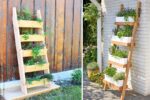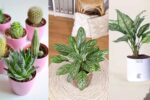Join on WhatsApp
Get the latest updates directly on WhatsApp – motivation, news & more!
As autumn fades and winter’s chill begins to settle in, the garden landscape changes dramatically. Leaves fall, beds are mulched, and perennials are tucked in for their long winter sleep. But if you’ve got plants in containers, there’s one more important task to tackle before the frost truly sets in: protecting your pots.
Potted plants add beauty, flexibility, and personality to our gardens, patios, and entryways. But they’re also more vulnerable in winter. Unlike in-ground plantings, containers can’t rely on the insulating power of deep soil. Both the pots and the plants inside face risks from freezing temperatures, wind, and moisture. The good news? With a few simple steps, you can help your containers survive winter and return strong come spring.
Why Containers Need Extra Attention
Pots are exposed on all sides, which means cold air can reach the roots of plants from every angle. When temperatures drop below freezing, the soil inside can freeze solid, damaging or even killing roots. If the plant itself is not cold-hardy, or if the pot is made of a material that can’t withstand freeze-thaw cycles, the risks go up even more.
Clay, ceramic, and some types of terracotta are particularly vulnerable they can absorb moisture and then crack or shatter when that moisture freezes. Even plants labeled as hardy in your zone can suffer root damage in containers because the roots are less protected than they would be in the ground.
That’s why winterizing your pots isn’t just about plant health it’s also about preserving your containers themselves.
Choosing the Right Containers for Cold
The first step in winter-proofing your containers actually begins with the kind of pots you use. Some materials handle cold far better than others. If you’re investing in pots you plan to leave out all year, consider:
- Concrete and fiberstone: These are heavy and durable, with good resistance to cracking.
- High-fired ceramic: Not all ceramic is the same those that are fired at high temperatures are less porous and more frost-resistant.
- Plastic and resin: Lightweight and often designed for all-season use, these are generally more forgiving in winter.
- Metal: Can handle winter well but may conduct cold quickly, which affects roots.
Avoid low-fired terracotta unless you plan to move it indoors or shelter it. While beautiful, it’s extremely prone to cracking in freezing weather.
Elevate and Insulate
Water is the enemy when it freezes and expands, especially when it gets trapped under or inside a container. That’s why elevating your pots slightly off the ground is essential. Use pot feet, bricks, or even a wooden slat to keep containers from sitting directly on concrete or soil. This prevents water from pooling underneath and helps drainage continue even in damp weather.
Adding a layer of insulation around the pots is also helpful especially if the container will stay outside through the worst of winter. You can wrap the pot in bubble wrap, burlap, or frost blankets. In especially harsh climates, some gardeners even wrap the entire pot in layers of insulation and top with plastic to keep it dry.
Grouping pots together can also create a small microclimate that shares warmth and reduces exposure.
What to Do With the Soil
One common mistake is leaving soil in empty containers over winter without checking its moisture level. Wet soil expands when it freezes, which can crack even the sturdiest pots. If you’re not overwintering plants in a container, it’s best to:
- Empty the pot completely and store it upside down in a dry place
- Or, at the very least, cover the soil with a breathable tarp or plastic to keep excess moisture out
If you’re leaving plants in place, try not to water them heavily once freezing temperatures begin to set in. Keep the soil on the dry side to reduce expansion risks.
Bringing Tender Plants Indoors
Not all potted plants are meant to survive the winter outside. Tropical and tender perennials like ferns, begonias, lemon trees, and certain herbs should be brought indoors before the first hard frost.
Before bringing them inside, inspect the plants for pests and remove any dead or diseased foliage. Acclimate them gradually by placing them in a shaded outdoor spot for a few days, then moving them indoors to a bright window or under grow lights.
For plants that go dormant, such as some bulbs or deciduous perennials, a cool, dark basement or garage may be ideal. They don’t need light, just frost protection and a little airflow to prevent mold.
Overwintering Hardy Plants in Containers
If you have hardy perennials or shrubs in pots, it’s still important to give them extra protection even if they’re rated for your zone. Remember, in a container, roots are more exposed.
Here’s how to help them:
- Mulch the surface of the soil with straw, bark, or leaves
- Wrap the pot in insulating material if needed
- Water occasionally during dry spells (yes, even in winter!) if the soil isn’t frozen
- Position pots out of wind, perhaps near a wall or corner where they’re shielded
Some gardeners even bury entire pots in the ground for winter, giving them the benefit of in-ground insulation without disturbing the roots. In spring, they lift the pots back out and return them to the patio or porch.
Storing Empty Pots
If you have extra containers that aren’t being used over winter, store them clean and dry. Scrub off any soil or plant residue to prevent mold or pests from settling in. Allow the pots to dry completely before stacking or covering. Store them in a shed, garage, or any place where they’ll be protected from repeated freeze-thaw cycles.
If space is tight, stack plastic or resin pots inside one another and store heavy ceramic ones separately to avoid cracks or chips.
Decorative Winter Displays
Not every container has to sit empty during winter. If you’d like your pots to continue adding beauty to your space, consider filling them with evergreen boughs, pinecones, dried seed heads, and winter berries. These displays don’t need soil or water and can be refreshed after snowstorms or wind.
Just make sure that any pot used outdoors, even decoratively, is winter-safe and elevated to prevent moisture damage.
A Little Effort, A Lot of Reward
Winter-proofing your pots may feel like one more thing on the seasonal to-do list, but it pays off. Come spring, you’ll be greeted by intact containers, thriving plants, and a garden ready to wake up without damage or disappointment.
By taking the time to protect your containers now, you’re not only saving money and effort later you’re extending the life and beauty of your garden across all seasons. A little care in the cold can mean a lot of green when the thaw returns.




